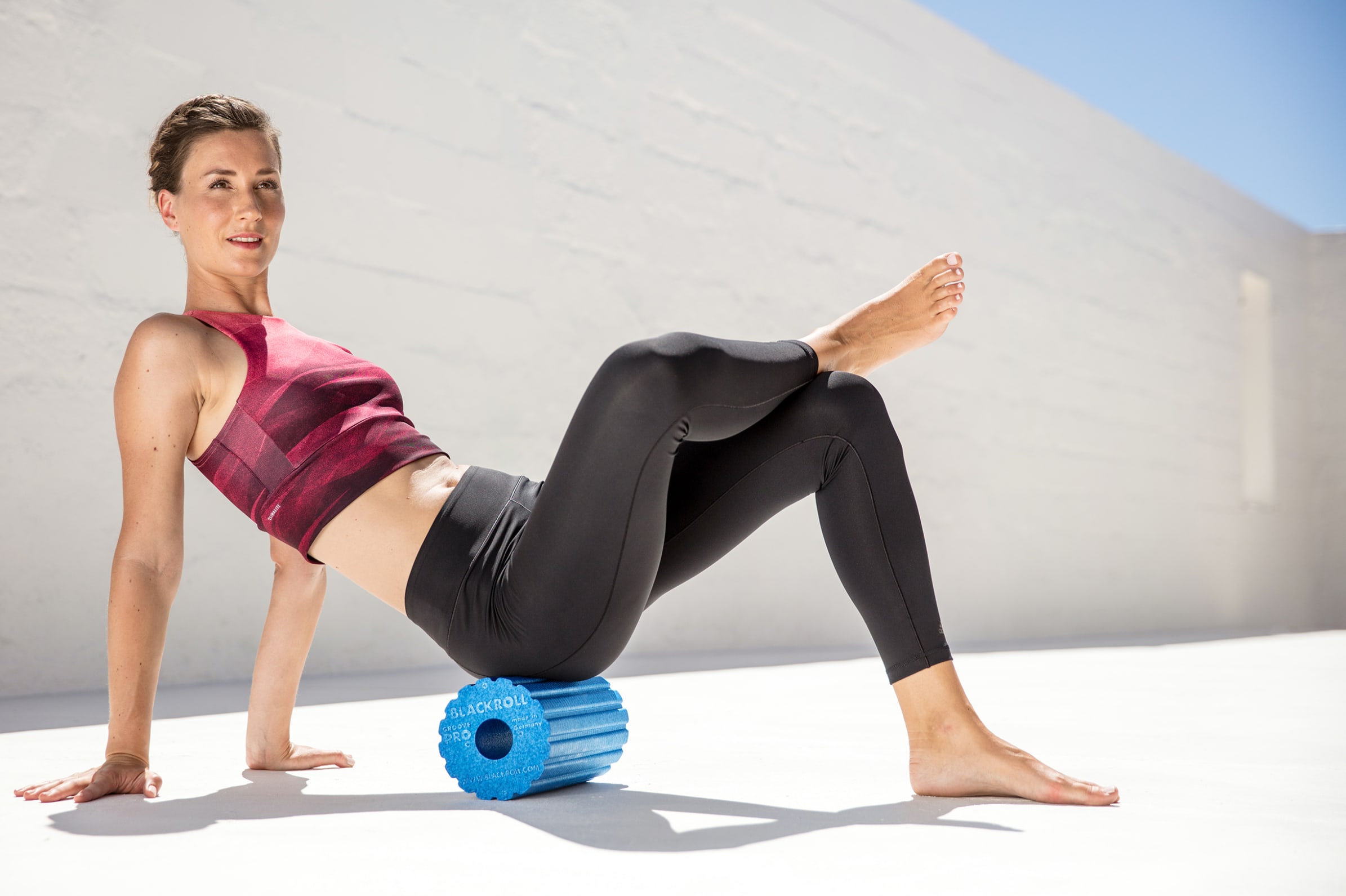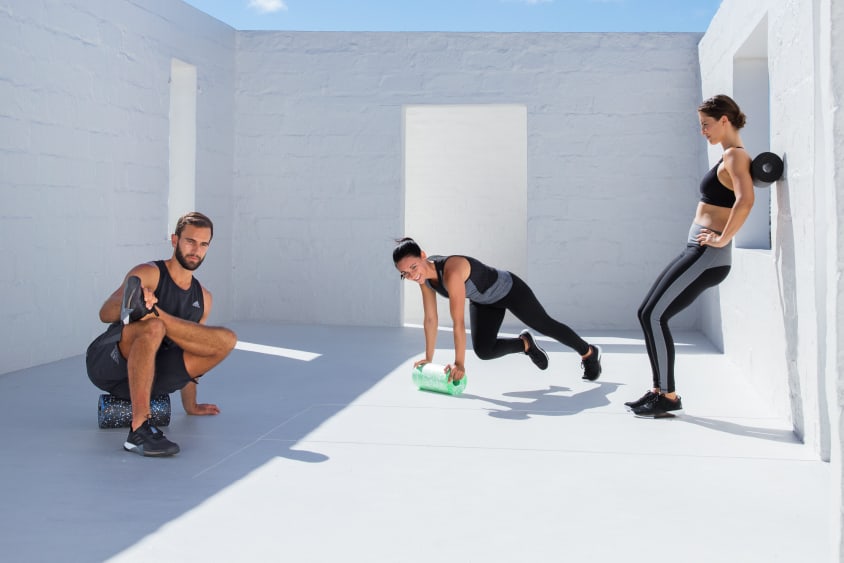
Is training with the foam roller dangerous?

We explain what lies behind the criticism of fascia training.
There are many positive effects that have made fascia training, or to be more precise foam rolling, so popular. It is a fast and simple way to improve your mobility, without having to limit your sporting performance. It activates mobility and flexibility, accelerates recovery, reduces pain, and not only can it support relaxation, but it can also reduce muscle tone. There are also highly promising findings from studies, which indicate improved recovery, enhanced arterial function and better intrafascial lubrication. To date, 84 studies have been published worldwide in international specialist journals, on the topic of fascia training. On this basis, we at BLACKROLL have been training trainers and therapists in the area of fascia training since 2004, and have been engaging in continuous dialogue with the scientific community for a number of years, which has lead to the ongoing revision of our training, as well as the expansion of our product range.
However, there are increasing instances of the foam roller being labelled as dangerous. Statements such as, “the pressure when foam rolling is hazardous to the venous valves”, “fascia training has no structural effect on the fascial tissue”, or “training with the foam roller poses a danger to the health” are typical examples of criticism levelled at fascia training. In this article, we will examine the criticism of fascia training and highlight the actual effect of fascia training, drawing on current studies with a view to eradicating any doubts.
First off: you don’t get something for nothing. If you do not stick at it, you will not achieve any long-term success:
“If mobility is measurably improved, use it. If you gain hip extension, use it. If you gain shoulder flexion, use it.”
Gray Cook
This quotation from the renowned physiotherapist in relation to foam rolling states that if you have improved your mobility using a foam roller, you should ideally keep on using it. Otherwise you might loose this mobility again, and as such will not improve your posture or your pain in the long term.

8 important points on the topic of foam rolling
01. Foam rolling and static stretching compared with regard to the improvement of mobility
Foam rolling results in an improvement of mobility. This is widely accepted amongst experts in the field. The most extensive study, and the study of the highest quality on this topic, was published by Scott W. Cheatham, with his “Systematic Review” in 2015.
According to current studies, classic stretching and fascia training are almost identical in terms of the gained increase in mobility. however, there is one major difference when it comes to static stretching, which can have a detrimental effect on the body. This relates to neuromuscular performance, i.e. the excitability of the muscle fibres of the stretched muscle is significantly decreased. This results in impaired sporting performance immediately after stretching. And this is not the case with fascia training.
Conclusion: You thus achieve a comparable improvement in mobility within the same period of time, without reducing your neuromuscular performance. A genuine game-changer for you, and for all other athletes!
Regarding the long-term effect of the exclusive practice of fascia training measures, there is still a degree of uncertainty, and findings are also contradictory. In a study with active footballers, for example, eccentric exercises with fascia training with a view to improving ankle joint mobility were studied. The acute effects after 30 minutes were comparable with both interventions, whereas only the eccentric exercises showed an improvement in terms of the long-term effect (4 weeks after the standardised training protocol).
These results contradict the two-month study on a group of 37 active and healthy women, die who were divided into a control group and a fascia training group. Both groups completed a training session twice weekly, with the only difference being that the fascia training group then supplemented the session with a fascia training programme. After two months, this group showed significantly better results in the functional mobility and stability test (Functional Movement Screen, or FMS for short), whereas there were no improvements whatsoever observed in the control group.
Of course, these are only initial findings with small test groups, and further studies are as yet required in order to be able to draw accurate conclusions.
However, we can say this: foam rolling offers the greatest benefit when it is combined with other exercises and/or interventions.
There is still a degree of doubt as to which physiological effects like behind the improved range of motion (ROM for short). According to Scott W. Cheatham et al. (2015) the acquired flexibility is down to visco-elastic (i.e. high deformability in spite of very firm tissue) and thixotropic (i.e. increasing viscosity of the surrounding fluid on account of the increased interlinking of the fasciae) changes to the fascial tissue. This should, in turn, result in the better lubrication of the fascial layers as they glide over one another. It was possible to confirm this assumption in 2017, thanks to the studies conducted by Wilke, although the effect still requires further study (de Souza et al., 2019). And very importantly: this finding must not be confused with an actual structural change to the superficial fascia, which is too tough to be influenced by foam rolling.
According to Kelly and Beardsley, 2016; de Souza et al., 2019, the most likely explanation is probably that the acquired flexibility has an effect on the central pain modulation system. The constant, strong pressure could “overload” the fascial receptors, which could result in a minimisation, or even the complete inhibition of the stretch receptors. In addition, the “neuronal” barrier would be overcome, and the central nervous system would allow a greater range of movement. The reduced pain perception has already been observed in multiple studies, e.g. Aboodarda et al. (2015) or Cavanaugh et al. (2017).
02. Foam Rolling and enhanced performance
There has been criticism that foam rolling does not improve the user’s performance immediately after use. In any case, fascia training does increase mobility without reducing your power output. This is a clear advantage, even if it does not result in a direct performance increase after use. The studies were conducted in order to find out whether foam rolling does not limit output simply because self-massage reduces muscle tone when at rest, and increases the range of motion. More information on this subject is available here.
03. Fascia training and improved recovery
In a meta analysis of 21 studies it was possible to demonstrate a clear reduction in subjective pain perception. In addition, the effects on the measured flexibility were again positive, and improved arterial function, as well as the increased activity of the parasympathetic nervous system, were recorded. In any case, these are clear indications of systemic relaxation, and are thus highly beneficial when it comes to recovery.
These results can also refute the hypothesis that fascia training does not aid recovery, and rather promotes pain and muscle soreness.
What effect lies behind the reduced pain perception?
This has not yet been sufficiently clarified. One current hypothesis, based loosely on Kai Hill et al., 2014; Macdonald et al., 2014 states that training-induced muscle soreness occurs primarily in conjunction with connective tissue damage and inflammatory reactions.
While the acute inflammation reaction increases the osmotic pressure within the tissue, pressure acts on the surrounding nocireceptors (pain receptors) and can thus result in painful reactions following your intensive muscle work.
An explanation for the positive effect following fascia training: generally speaking, rolling stimulates the metabolism between the cells. This can play a supportive role when transporting away metabolites.
The fact that the use of a foam roller following intensive muscular and neuronal strain can result in significantly faster recovery is demonstrated in our example:
In a small pilot study of 20 men with experience in weight training, all participants were divided into a fascia training group (n=10), and a control group (n=10). On various days, both groups performed firstly a 1 RM Back Squat Workout and a 10 x 10 Back Squat Workout. Here significant improvements in terms of subjective muscle pain perception were recorded within the foam rolling group (Post 24-48-72). In addition, the vertical jump height (Post 48) was much better than in the control group. A clear result, even if it was just a very small test group.
04. Fascia training and selecting the correct roller
When foam rolling, you should not roll in just one, but ideally in both directions – forwards and backwards, left and right. Vital here are the pressure exerted, and maintaining a moderate speed when rolling. The many positive study results in this regard speak for themselves, and eradicate any uncertainties concerning rolling direction. There are no side-effects when foam rolling and the benefit of rolling in both directions has been scientifically proven.
05. Foam Rolling and blood pressure
According to a current study, elevated NO values (nitric oxide) could be observed following fascia training. The elevated NO value was deemed to be positive, as it correlates with a drop in blood pressure. It was also determined that the heart rate variability (shortened to HRV) was increased. This represents a clear indication as to the relaxing effect of foam rolling. However, due to the small test group, fascia training cannot be touted as the latest method for lowering blood pressure. That said, the results are once again very promising and extremely positive.
06. Foam Rolling and circulation
According to renowned fascia researcher Dr. Robert Schleip, very positive effects can generally be demonstrated in the area of blood flow and fascia training. For instance, a study from 2014 in the Journal of Strength and Conditioning Research showed that the concentration of nitric oxide in the test subjects’ blood plasma was elevated after rolling. Nitric oxide relaxes the blood vessels, and makes the vascular walls elastic. It also prevents the clumping of platelets; meaning the substance has a positive effect on the fluidity of the blood. A wide range of medications make use of the vasodilatory effect of nitric oxide, including Viagra. In their study, the scientists concluded that self-massage with the roller reduced the rigidity of the arteries and improved endothelial vascular function.
Further very promising findings were also provided by a study conducted by Thilo Hotfiel et al. (2017). Following the self-massage (whereby the lateral thigh had been rolled) arterial circulation was significantly improved.
Furthermore, the pressure applied to your body when using foam rollers poses no danger to the lymphatic system or the venous valves. In any case, foam rolling is not performed statically, but rather dynamically, while moving. This means that occlusion (that is, the pathological closing of the blood vessels) is limited to a minimum period of time within the context of overall application.
07. Fascia training and contraindications
In order that fascia training always has a positive effect on your body, you should have potential contraindications ruled out before you begin practising self-massage. This includes, for example, all skin lesions, acute inflammatory processes, cancer, recent injuries, thromboses etc..
08. Fascia training and manual pressure
Depending on the localisation and the “type” of fascial tissue, a pressure of several hundred kilos would be required in order to have a structural effect on the fascia itself. Therefore, manual pressure when foam rolling is not sufficient to have an impact on the fascia tissue.
With this in mind: we hope you really enjoy training with the foam roller. We also hope we have been able to shed some light on the conjectured dangers of fascia training.




